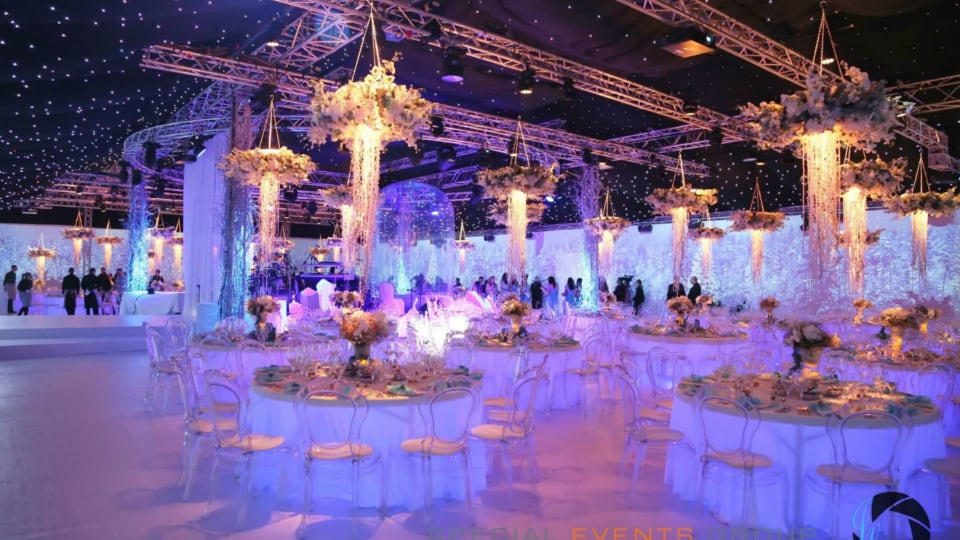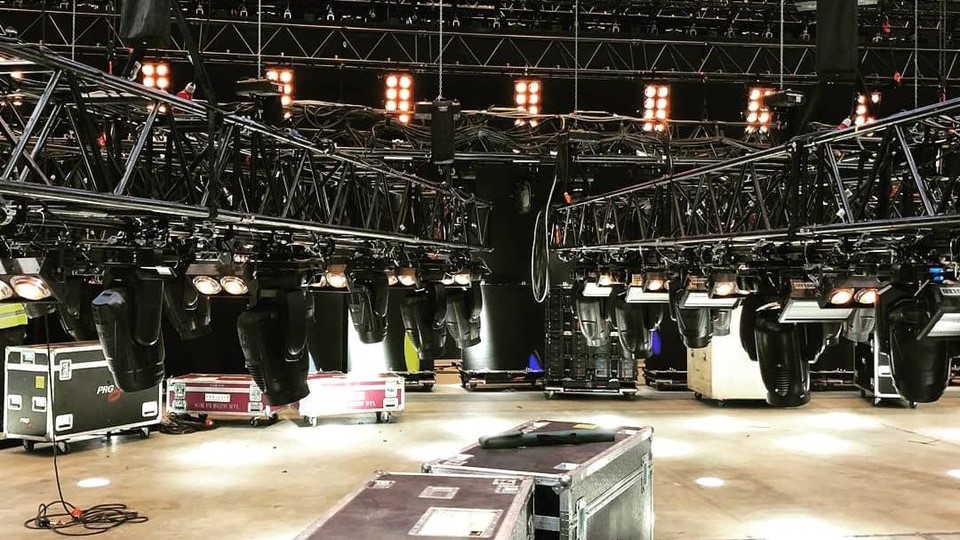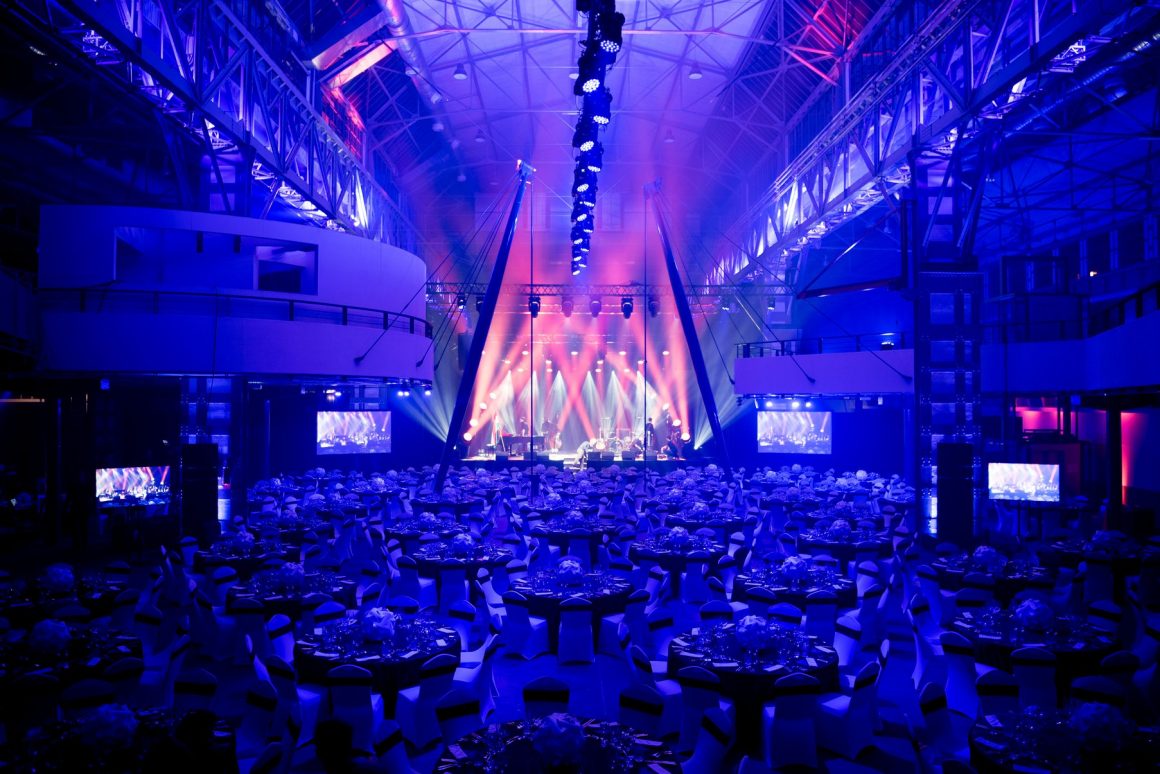Wash and stage lighting by our Hungarian member company Special Effects Ltd.
In a previous article about event lighting, we explored in detail the purposes and the different uses of event lighting solutions for certain event types. We also used quite a lot of expressions – names of lighting fixtures and techniques, for instance – that may have left you scratching your head as to what they mean. So this time around not only will we explain what they are, we will also dive deeper into the different kinds of lighting types and the effects they can achieve for your event.
Before we go any further and dive into what the most perferred lights are in venues, let us start with the basics, more precisely with the lights that most of the fixtures we will give you in this article are made with:
LEDs
Most commonly known by their acronym, Light Emitting Diodes are energy-efficient, reliable, long-lasting, and of course cost-effective event lights that can be used in a myriad of ways and are the number one lighting type used nowadays for any event.
Since LED consume much less energy than other light bulbs, they also generate considerably less heat during use. This is just one aspect of them being an environmentally friendly option, and it also allows you to safely incorporate a large quantity of LED lights in your event without worrying about their safety and excessive energy consumption.
Decorative lights are usually made with LED, which allows them to continuously illuminate objects and spaces without overheating or physically impacting the surface – and graphics – of the materials they light up. This makes them ideal for venues in event lighting.
So what kind of decorative lights are we talking about? Let us give you a few examples!

Decorative event lighting showcased by our AV Alliance member SEG in Sofia, Bulgaria
Decorative event lighting
As we explained in the first part of this article, decorative lights are fixtures that are installed purely for the purpose of creating a certain mood and evoke emotions from the audience, in accordance with the theme of the event. They are used to enhance event decor and architectural features, setting the tone of the entire event.
Uplight
As the name implies, uplights are fixtures that shine upwards from the ground onto drapings, walls, pillars, etc. Of course, uplights do not need to be positioned directly under the surface you wish to light up, nor do they need to face straight up: place them at an angle to create an interesting lighting effect. Uplights can also be lit up in different colors to create a certain mood, or to match your brand image or your event’s theme.
Backlight
Backlighting means using a source of light to illuminate a subject from behind (or within). This technique helps to make the subject “pop” in front of the background, visually separating it by creating contrast, which is recommended especially for a video recording of people on stage.
Hair light
Hair light is quite similar to backlighting, in fact the light source is once again placed behind the subject and it is also used to give more dimension to people on stage. Since the light is not just behind but also above the person, the angled downward effect helps eliminate shadows and it creates a halo-like light around them.
Accent lighting
There are other ways to draw attention to specific objects or areas at your venue, and accent lighting in one of them. These can be used to highlight products, architectural features, furniture, decoration etc.
Arm light
Similar to accent lights, arm lights are also used to showcase certain objects, for instance pictures, artwork, displays, or exhibit walls. As the name implies, arm lights come with brackets or “arms” that mount them on or over the object in question and thus allow the light to illuminate it from above. Due to the nature of arm lights they are only suitable to cast limited amount of light and they are not only close to the object but they are also prone to produce considerable heat, therefore it is advised to pay attention to how that heat affects the material of the object that this fixture is used to showcase.
Layered lighting
There are many creative ways to combine the effects of different light sources, for example through layered lighting. A good example for this would be to add gobo pattern projection or hang decorative light fixtures in an area that is already illuminated by e.g. a color wash or uplights, creating a unique ambiance.

Gobos in action: decorative event lighting by our member CPR MultiMedia Solutions
This is the moment where we also explain what the mysterious sounding gobo really is.
Gobo
A gobo is a surprisingly cost-effective way to project patterns with light, thus it is frequently used for different events. The gobo itself is a steel or glass plate that is placed in front of the light source to manipulate the direction of light, and ultimately create the desired shape or pattern on the illuminated surface. Ideal for event lighting, gobos can be custom-made to project company logos, signatures, and personalised designs, a popular feature at e.g. corporate events, product launches, concerts, fashion shows, and even weddings. Gobos also come in custom colors to match your brand identity and your event’s theme.
Gobos can be applied to different light fixtures, such as moving heads, spotlights, and even projectors to create the desired effect you are aiming for. Gobos come in a number of standard sizes that fit most light fixtures in the market. Many lighting manufacturers have created their own custom products such as gobo rotators to combine multiple patterns and thus create animation effect.

Different types of stage lighting combined by our Icelandic AV Alliance member Luxor
Stage lighting
Gobos are also a great addition to stage lighting, which we are going to talk about in more detail below. But first: what is stage lighting? It does not necessarily mean the lighting has to literally be directed on a stage, rather it is used to focus the audience’s attention to the performers, presenters, etc. through colors and light-dark contrast. What popular types of stage lighting are there, you may ask?
Wash
Unlike uplights, the wide beam of washes (or stage washes) spreads a wide, even light field over a larger area, e.g. your stage or event floor, and thus provide a great base for additional illumination (projection, uplighting, different LED fixtures, laser lighting etc.) and decoration. Having no harsh edges like the light coming from spots does, washes seem less crisp and bright even though they emit the same amount of light (lumens) as spots.
Color wash
Of course, washes also come in colors (sometimes called fill lighting), creating a unique ambiance by bathing any room or stage in homogenous, even light, which is a great way to incorporate brand colors at gala dinners, for instance. There is also an option to combine different colors that blend into each other to bring more fun into the event space.
Spotlight
Spotlights are probably the most well-known stage lighting fixtures. Contrary to washes, the purpose of spots is to directly shine light on an object that you want your audience to focus on, for instance your speakers or performers, or any object that needs to be the center of attention. Spots create defined light circles with harsh edges without the softness of the washes.
Ellipsoidal / Leko
A popular feature in stage lighting are Lekolite (Leko) or ellipsoidal reflector lights, which are powerful fixtures with long cylindrical bodies and one or more lenses, which are primarily used to focus strong but smaller diameter beams on the stage.
Par can
Often called parcan or PAR (short for parabolic aluminized reflector) lights, these fixtures are another popular – and most commonly used – stage lights, for example in theaters. These days their more energy-efficient LED version is used, which also has brighter, clearer light output than traditional par cans. Most par lights have a cylindrical body with a reflector to concentrate and emit the classic oval-shaped light. LED pars are commonly used to create wash effect over large areas.

Intelligent lighting
Stage lighting can be achieved both by conventional, stationary lights (that can only be moved manually) or by automated moving fixtures, depending on what you wish to achieve for your event – some light types, such as washes and spots can be either. Moving lights are remotely controlled or even pre-programmed in order to rotate, tilt, pan, change colors, and dim through a lighting console.
Intelligent / automated lighting
Often called robotic lights, too, these LED fixtures can be fully controlled to create movement and depth for stages, event floors, ceilings, walls, etc. at any event venue, from theaters and conference rooms to auditoriums and stadiums. Moving lights can be rigged on trusses or placed on or around the stage. For added effect intelligent lights can be combined with decorative lights or even special effects (such as haze or fog machines) to create an even more unique ambiance. Intelligent lighting is programmed and operated by control systems that allow you to be as creative in your lighting design as possible and turn your event into a breathtaking experience for your audience.
Moving head
Moving heads are the most common type of automated lights and also the fixtures most associated with event lighting, and are heavily featured at festivals, concerts, parties, etc. These fixtures emit powerful beams of light while having a full range of motion: circular, tilt, pan, and even 360° rotation. Moving heads can also integrate and project gobos. As we mentioned above, some lighting types both have static and moving versions, and moving heads are a great example as they come in three variations: spots, washes, and beams. Some manufacturers, such as AV Alliance technology partner Elation Professional, have hybrid fixtures in their portfolio, which incorporate all types in one.
So, what are arguably the most heavily used and the most favorite light fixtures in concerts and festivals?
- Spot moving heads work with a wide beam angle in order to be able to project gobos, and are capable of splitting the emitted light into more than one beams, creating a spectacular visual effect.
- Similarly to static LED par cans, wash moving heads bathe large surfaces in even light, but in addition they have movement and the angle and colors can be controlled and even have a zoom effect added.
- Unlike spots, beam moving heads have a narrow beam angle, and similarly to ellipsoids, their beam is very bright, defined, and precise, which works well over distances, making these fixture ideal for concerts and festivals, for instance.
- Hybrid moving heads integrate all three luminaries – spot, wash, and beam – in one fixture, and often come not just with a bigger price tag but also with a whole range of built-in features such as gobos, manual and automatic focus, zoom, color mixing, strobe effect, etc., just like Elation’s Proteus Hybrid moving head.
Laser light
Laser lights are quite different from other event lighting types due to stark contrast in their appearance. They emit, as the name implies, laser-thin light beams over large distances and can be easily programmed, which makes them a hugely popular feature of festivals, concerts, and theatrical performances.
Lighting control systems
Control systems, or lighting consoles, are used to design lighting for your venue, and program the movement and function of the different intelligent lights within the system. This allows you to transition between different parts of your event by adapting the lighting to what is currently happening, direct the focus of your audience, and create a different atmosphere by changing the colors, the brightness, etc. This makes lighting control systems a crucial element of event lighting.
Lighting control is an art of its own, and it has evolved considerably over the past years. It has gone from a massive set of faders to control lights individually to a complex system of encoders that program the movement of each fixture, the color adjustment of each LED, etc. To explore these devices and their use further, we will dedicate the third installment of our blog series on event lighting entirely to control systems, how they work, which kind of lightboard fits your event best, and what can be achieved through them.
Expanding your lighting vocabulary
AV terminology can often be intimidating and confusing, therefore in addition to all of the above, we collected a few more expressions and lighting terms that you often come across while preparing for your event.
Ambient light
The natural, existing light of a space or venue coming from the windows and doors, house lights, etc. Ambient light is in a way the bane of every AV professional’s existence, as it has to be either incorporated or controlled in order to avoid letting it interfere with the event’s own lighting. It can be controlled by using shades, turning off house lights, cover light sources, etc. If ambient light is too bright and cannot be managed efficiently, e.g. on an exhibition floor, LED lights and stage lighting can be used to counter it.
Barn door
Barn doors are shutters on fixtures that keep light from bleeding out to outside areas. These shutters consist of 2-4 metal flaps that are attached to the light fixture.
Beam angle
It is essentially the angle of the cone of light emitted by a light fixture, and depending on the width of the angle the beam becomes narrow or wide, impacting its intensity and brightness.
Channel
In a lighting control system channel means the complete control path of signals, controlled by the lighting operator.
Conventional lighting
Conventionals is the collective term of standard stage lighting fixtures which are static, non-moving lights, and not LED.
Crosslight
A common feature in theatrical and dance performances, crosslight is a lighting technique that illuminates performers from the side of the stage towards the center, thus avoiding casting shadows that take away from the visual impact of the performance.
Downlight
An opposite of uplight, this technique casts light – most commonly wash or spot – directly from above the stage.
Fader
A control device that increases and decreases the intensity of a light source in stage lighting. Most LED luminaires have built-in fader control.
Kelvin
Kelvin is the measure of color temperature (i.e. warmth and coolness) in light sources, an important factor that influences the ambience of a venue or the mood of an event.
Light curtain
A lighting effect that creates a – sometimes colorful and tilting – wall of light over artificial smoke.
Light tree
Also known as booms, light trees are metal poles on a stand that is used to mount lights on the ground instead of rigging them on bars.
Luminaire
Luminaire is another term for lighting equipment, used mostly in Europe.
Rigging and truss
Lighting equipment is often mounted (rigged) on truss structures that are used to hold up various AV equipment (speakers, etc.)
Soft light
A lighting technique that eliminates shadows (e.g. in a studio environment or broadcast) and balances the main light.

Selecting the right light fixtures for your event is a complex project, and it takes more than just knowing what each type of light is called and what it does; understanding how they work together, how they enhance the ambiance, the mood, and the overall event experience, and how they can be controlled to maximize their capabilities to create a spellbinding show is a task for experienced lighting designers and AV professionals.
As promised, in the next installment of our event lighting blog series we will explore the world of lighting control systems, and bring you examples of how and for what types of events they can be used.
To learn more about the technical aspects event lighting, the necessary equipment, as well as the related costs, feel free to get in touch with us and find out what our AV Alliance members can do to make your event dreams a reality!

